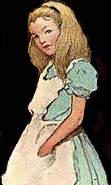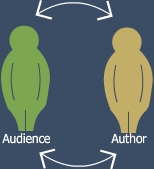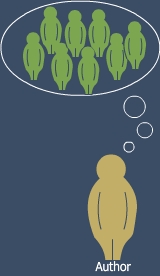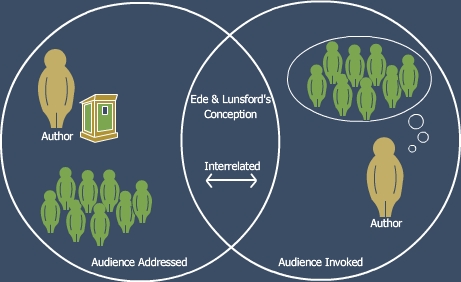Through the Looking Monitor: Alice in Wikiland
 Wikis and the Rhetorical Audience
Wikis and the Rhetorical Audience
Since the inception of wikis and their subsequent embrace by the educational community (Garza, 2005; Barton, 2004; Lamb, 2004; Ferris and Wilder, 2006; Glogoff, 2006; Grant, 2006) in recent years, the definition of audience has become as crucial as it was when Ong, Ede and Lunsford, Elbow, and Murray wrote their groundbreaking articles on the subject. The audience to and for which members of the wiki community write, presents a fluid dynamic of interchanging and interpersonal definitions of what it means to be an audience member and what it means to be an author. Due to the intricate nature that the two rhetorical concepts share, audience and author maintain a reciprocal and cyclical relationship. An author must have an audience and visa versa (even if that audience is the author).

Figure 1.1: Audience/Author Relationship
Audience, defined in its broadest terms, is the body of readers who will interpret a text (for a wiki is a text-driven community). This body of readers can be imaginary or real, explicit or implicit. This text will explore five types of audiences in a wiki: 1) the single-member audience, 2) the limited audience, 3) the undefined audience, 4) fictional audience, and 5) audience addressed/audience invoked. Each of these categories, as Lloyd F. Bitzer defines, “consists of those persons who are capable of being influenced by discourse and of being mediators of change” (p. 221).
The notion of the “audience of one” and the “self as audience” fall into the category of single-member audience. Both rely on the perspective of one individual offering counterclaims to the actual argument offered to the audience. The single-member audience might represent the teacher-grader figure, the author-authority figure, or the self-author figure. The teacher-grader is the instructor to whom the argument is directed in an educational setting and in the case of the wiki, it is the course’s wiki facilitator. The person in this role has the authority of dispensing “grades” and whose words may hold more weight than other audience members due to the grade-dispensing capacity. Teachers often attempt to lighten this weight by either anonymity (students identities are secret to each other through pseudonyms) or creative grading policies (peer-review being one example). The author-authority figure is the individual who “authored” specific content on the wiki and thus other community members’ comments may not hold the same weight (an issue of credibility), similar to the situation presented by the grade-dispenser role. Alice will experience this audience position as she writes one of her later essay assignments to be evaluated through peer-review. Instructors often try to counterbalance this aspect of authorship by using a wiki in the first place, which allows users to edit another author’s material, thus making the author, as a single entity, less visible. While editing in the wiki is transparent, the author of revisions may be opaque to audience members without identifications in place (user login, etc.), creating a unique relationship between authors and anonymity. The final single-member audience is the self. Perelman and Olbrechts-Tyteca perceive the self as audience as a manifestation of the universal audience and one that cannot help being sincere to the author. The case of sincerity is often a complicated one noting the possibility of self-deception. The notion of self-deception aside, this member of the audience has the potential for the closest examination of the argument and will more likely, due to self-fondness (and trust), hold the most weight for the individual author, and will likely be the audience member whose mediation enacts the most change in the attitude or opinions of the author.
The next audience is the limited audience. This audience represents the wiki community and the academic community. Within the wiki community, the category subdivides into A) the class member(s), B) the larger community, and C) the academic/scholarly community. The class member is composed of the individual author or authors that comprise the instructor’s course. These are the students, including Alice. The larger wiki community could be anyone involved in the maintenance and contribution to the wiki. These members are those that represent other classes (if the wiki is used intra-course or across multiple courses), those individuals who possess access directly from the instructor and are related in some way to the topic of the community, and includes the instructor his or herself. The academic/scholarly community is that audience which reads and possibly contributes to the wiki, but is not involved in one of the wiki instructor’s courses and is not a student, though graduate students teaching with the wiki could be members of this audience. This audience category is one that participates in the discourse of the community in an observational manner and whose action or mediation of change through the community knowledge argument is essential in order to enact community-wide transformations. The academic community can represent an authoritative perspective since these are members who are potentially invested in the discourse of the larger community, though a class wiki creates its own unique discourse community centered on the instructor's course; this community applies to larger, multi-course or discipline specific wikis. Thus, in the narrative assignment, Alice would not see this audience or feels its affects, but it could represent other FYC instructors who evaluate student writing at the end of the semester, such as that in done in a portfolio system.
The third audience is the undefined or multiple audiences. The reason this audience is termed “undefined” is that it may represent the “imagined audience” Herrick records, or the world and cyber audiences. Since wikis occupy a rhetorically changing and virtual space, the audience cascades into a large, world audience inhabiting a cyber reality. Student texts are no longer limited to the teacher and classmates, but instead open to the technological world of those who have access. Alice would see this audience as anyone with Internet access who is able to view the wiki through the web. This audience represents the largest section of audience members and may be realized, or implicit. Wikis allow students to access a “universal audience,” which therefore conducts the audience in the role “equal to that of the orator in the tests of ideas publicly” so that the community or authors principles of action “cannot arbitrarily favor certain people of certain situations,” thus providing a somewhat Neutral Point Of View (NPOV) (Herrick, 2001, p. 199). In other words, as the ideas of the wiki are publicly tested through the wider audience (the wider the better), the point of view draws closer to a neutral, or generally acceptable one. The wiki community in particular may or may not see the affects of the universal audience mediation, but this does not imply an absence of mediation.
The above continuum of audience as self to known to mass unknown has been criticized for failing to recognize the nuances inherent in the audience structure. In light of these nuances, this section will also consider Ong’s audience as fiction and Ede and Lunsford’s audience addressed/audience invoked. Consequently, the fourth audience is that of Walter Ong’s fictional audience, as stated in his groundbreaking article, “The Writer’s Audience is Always a Fiction.” Ong (1975) wrote that the writer must “construct in his imagination, clearly or vaguely, an audience cast in some sort of role . . .” and that this same audience must “correspondingly fictionalize itself” (p. 60). In the wiki community, this means that audience members are constructed by the author(s) of a given piece based, as Ong believes, on past fictionalizations of previous audiences who assumed roles related to other audiences for other (previous) authors. The wiki single-author is related to all other community authors, knows what those authors contributed to community knowledge, and thus conjures up the audiences needed to continue the conversation.

Figure 1.2: Author Conjuring Audience
In this capacity, Alice would see her other group members in the narrative assignment as potential and realized audience members (including her instructor). Alice is related to these audience members because she is in fact, one of them, while remaining an author as well. The wiki audience is both author and audience as these lines are blurred, since a given audience member may decide to contribute and thus take on the role of author and recreate his or her own audience.
The final category of audience to examine is that of the audience addressed/audience invoked (AA/AI). Ede and Lunsford note the differences between traditional rhetorical conceptions of audience as addressed, the “actual or real-life people who read a discourse,” and newer conceptions by Russell Long and Walter Ong of audience invoked, “the audience called up or imagined by the writer” (p. 156). Ultimately, Ede and Lunsford propound a conception of audience that lies in the middle ground and notes the interconnected relationship between audience addressed and audience invoked.

Figure 1.3: Ede and Lunsford’s Audience Conception
However, in their 1996 critique, “Representing Audience: "Successful" Discourse and Disciplinary Critique,” Lunsford and Ede reexamine their initial conception of AA/AI, arguing particularly that the positionality in the essay expressly supported the Western rhetorical tradition with an “emphasis on ‘success’” that “has exacted a high hidden price. For how better to avoid misunderstanding and failure (and to make "successful" communication more likely) than to exclude, to disenfranchise those who by their very presence in the arena of discourse raise increased possibilities for communicative failures” (p. 174). In addition, the authors contend that their original essay "consistently downplays the possibility of tension and contradiction” (p. 170), when in fact, “[r]epresentation, of ourselves as well as of those audiences that we both invoke and address, can never be innocent” (p. 176).
Building further on reflection and the addition of digital media such as wikis to their concept of audience, Lunsford and Ede (2009) maintain that new (and digital) literacies expand and challenge notions of authorship and audience. Drawing on the work of Knobel and Lankshear (2007), Ede and Lunsford recognize that “[i]n a cyberspatial-postindustrial mindset,” the distinction between author and audience is much less clear than in that of the physical-industrial mindset of print literacy” (p. #??). The examination in this webtext seeks to draw on these scholars statement that “[i]n our contemporary world of digital and online literacies, it seems important to question the status and usefulness of the concept of ‘audience’” (p. #??). This text asserts what Lunsford and Ede assert: that audience in digital, participatory spaces is complex and multiple.
In a digital world, and especially in the world of Web 2.0, speakers and audiences communicate in multiple ways and across multiple channels, often reciprocally. And this momentous shift has challenged not only traditional models of communication but also the relationship between “creators” of messages and those who receive them. Today, as we have pointed out, the roles of writers and audiences often conflate, merge and shift.
It is precisely this conflation, merging, and shifting that wikis participate in revealing. The multiple audience identities that students can experience in digital, participatory spaces supports postmodern notions of multiple selves and constructs opportunities for increased audience awareness.
The wiki audience also maintains a complex and changing relationship that is not as static as addressed or invoked notions of audience would allow. The audience interplays in a relationship that is not dichotomous, but interrelated. As the members change, so do the authors’ notions of that audience change and the “vision” “conjured” by the authors “by using all the resources of language available to them to establish a broad, and ideally coherent, range of cues for the reader” is then “shared” by the wiki audience (Ede & Lunsford, 1984, p. 167). Alice's audience becomes real when she sits with her group mates developing a narrative outline for their assignment. That same audience becomes imagined as she leaves school and prepares to complete her portion of the assignment from another location, be it library or home. Thus, the very idea of audience becomes severely fluid.
The concept of audience is challenged in the wiki because students now have to consider the identity of the audience on a much larger scale, since they have the ability to “publish” materials online. Though this audience may be limited by administrators, the students’ conceptions of audience are still challenged through the immediacy of the audience and its impact on the physical (or digital) text. The audience is now an amalgamation of single-member audience, limited audience, undefined multi-audiences, fictionalized audience, addressed, and invoked audience. The audience could be sympathetic to the views of the wiki community, such as other composition teachers viewing another instructor’s course wiki for ideas, or hostile to the community such as one political party vandalizing another’s wiki. The notion of audience is certainly one that wiki instructors are not only provided an outlet to confront with students using a wiki, but also obligated to explore if students are to be offered tools to improve their communication skills and understanding. Alice now has a new set of concepts to confront that differ greatly from the ideas of audience with which she entered her composition course. These newly developing notions of audience are impacted and created by the community developed in the wiki and the community created in the classroom.